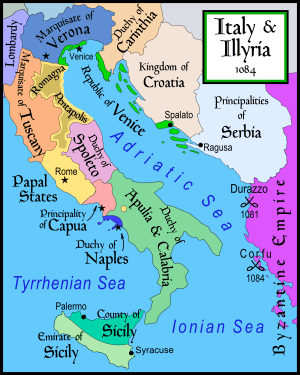County of Apulia and Calabria
| County of Apulia and Calabria | ||||||||||||||
| Contea di Puglia e Calabria | ||||||||||||||
| Vassal state of the Papacy | ||||||||||||||
| ||||||||||||||
 Coat of arms
| ||||||||||||||
| Motto Servire Nescit | ||||||||||||||
 The Duchy in the political context of Italy and the Balkans in 1084. | ||||||||||||||
| Capital | Melfi (1043–1077) Salerno (1077–1130) | |||||||||||||
| Languages | Norman, Neapolitan-Sicilian, Greek (minority) | |||||||||||||
| Religion | Roman Catholicism | |||||||||||||
| Demonym | Normans (generally), Apulians, Calabrians | |||||||||||||
| Government | Feudal absolute monarchy | |||||||||||||
| Count/Duke | ||||||||||||||
| • | 1043–1046 | William I | ||||||||||||
| • | 1059–1085 | Robert I | ||||||||||||
| • | 1111–1127 | William II | ||||||||||||
| Historical era | Middle Ages | |||||||||||||
| • | Lombard lords elect William of Hauteville as Count | 1043 | ||||||||||||
| • | Norman conquest of Salerno | 1076 | ||||||||||||
| • | Emperor Henry III recognize the County | 1047 | ||||||||||||
| • | Battle of Civitate; Pope Leo IX recognize the County | 1053 | ||||||||||||
| • | Treaty of Melfi; the County become Duchy | 1059 | ||||||||||||
| • | Death of the childless William II | 1127 | ||||||||||||
| • | Coronation of Roger; Duchy annexed to Sicily | 1130 | ||||||||||||
| Currency | Follis (common) | |||||||||||||
| ||||||||||||||
| Today part of | | |||||||||||||
The County of Apulia and Calabria, later the Duchy of Apulia and Calabria, was a Norman country founded by William of Hauteville in 1042 in the territories of Gargano, Capitanata, Apulia, Campania, and Vulture. It became a duchy when Robert Guiscard was raised to the rank of duke by Pope Nicholas II in 1059.
The duchy was disestablished in 1130 when the last duke of Apulia and Calabria, Roger II of Sicily became King of Sicily. The title of duke was thereafter used intermittently as a title for the heir apparent to the Kingdom of Sicily.
Creation
William I of Hauteville, who returned in September 1042 in Melfi, was recognized by all the Normans as supreme leader. He turned to Guaimar IV, Lombard, Prince of Salerno, and Rainulf Drengot, Count of Aversa, and offered both an alliance. With the unification of the two Norman families, Altavilla and Drengot, Guaimar offered official recognition of the conquests and at the end of the year, an assembly of Lombards and Norman barons at Melfi met with Rainulf and William, which ended at the beginning of the following year (1043). In this meeting, Guaimar V of Salerno ensured the Hauteville dominance over Melfi. William of Hauteville formed the second core of his possessions and differentiated himself from Rainulf I of Aversa, head of the territories of Campania. All the barons present offered a tribute as a vassal to Guaimar, which recognized William I of Hauteville as the first of the title of Count of Apulia. To tie it to himself, he offered to marry her niece Guide, daughter of Guy, Duke of Sorrento. Guaimar reconfirmed the title of count to Rainulf as well, which created the County of Puglia.
William stated that the first capital of the county, and home of the Crown would be Melfi, a city that would remain outside the partition. It would remain capital for forty years before being moved to Salerno: the center of the city was divided into twelve districts, each of them with a palace and a count with control over that area of town.
List of counts and dukes
William is usually considered the first count of Apulia and Calabria. In 1047, the Emperor Henry III took away Guaimar's ducal title. He christened William's brother and successor Drogo Dux et Magister Italiae comesque Normannorum totius Apuliae et Calabriae and made him a direct vassal of the emperor.
- Counts
- William I Iron Arm 1042–46
- Drogo 1046–51
- Humphrey 1051–57
- Robert Guiscard 1057–59
- Dukes
- Robert Guiscard 1059–85
- Roger I Borsa 1085–1111
- William II 1111–27
In 1127 the duchy passed to the count of Sicily. It was thereafter used intermittently as a title for the heir apparent.
- Roger II 1127–34, also king of Sicily (1130–54)
- Roger III 1134–48, son of previous, opposed by . . .
- Ranulf 1137–39, candidate of Pope Innocent II and the Emperor Lothair II
- William III 1148–54, also king of Sicily (1154–66)
- Roger IV 1154–61, son of previous
The title was left vacant after the death of Roger IV. It may have been revived for a short-lived son of William II. It was revived by King Tancred for his eldest son in 1189.
See also
References
- Chalandon, Ferdinand. Histoire de la domination normande en Italie et en Sicile. Paris: 1907.
- Houben, Hubert (translated by Graham A. Loud and Diane Milburn). Roger II of Sicily: Ruler between East and West. Cambridge: Cambridge University Press, 2002.
- Matthew, Donald. The Norman Kingdom of Sicily. Cambridge: Cambridge University Press, 1992.
- Norwich, John Julius. The Normans in the South 1016–1130. London: Longman, 1967.
- Norwich, John Julius. The Kingdom in the Sun 1130–1194. London: Longman, 1970.
- Takayama, Hiroshi. The Administration of the Norman Kingdom of Sicily. BRILL, 1993.